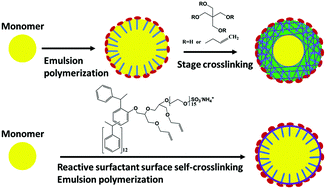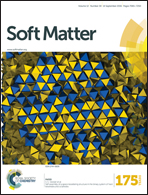Rheology and structure of surface crosslinked surfactant-activated microgels†
Abstract
Nonionic surfactant-activated microgels (SAMs), composed of hydrophobic alkyl acrylates and hydrophilic hydroxyalkyl esters that utilize the effects of surfactant mediated swelling and interaction to provide pH-independent rheological properties, were previously reported as a new pathway to the rheology modification of surfactant solutions. Crosslinking was shown to play an important role in the properties of these soft microgel systems. To understand the impact of crosslinking chemistry on SAM polymers, we have compared two types of SAM polymers: a conventionally crosslinked SAM polymer via allyl pentaerythritol and a novel SAM polymer, where the surface is self-crosslinked via a reactive surfactant. We have systematically characterized the polymer's swelling, rheology and microstructure in a model system containing the polymer, sodium dodecyl sulfate (SDS) and water. Surface self-crosslinking is demonstrated to be a more effective crosslinking approach to create surfactant-mediated interactions between the microgel particles, resulting in more effective rheology modification. Internal crosslinking hinders both the full swelling of the SAM polymer as well as inter-particle bridging interactions, and is therefore less effective. To our best knowledge, this is the first report on creating a novel surface self-crosslinked microgel via a dual-functional reactive surfactant that interacts with a non-reactive surfactant to create a yield stress fluid.


 Please wait while we load your content...
Please wait while we load your content...